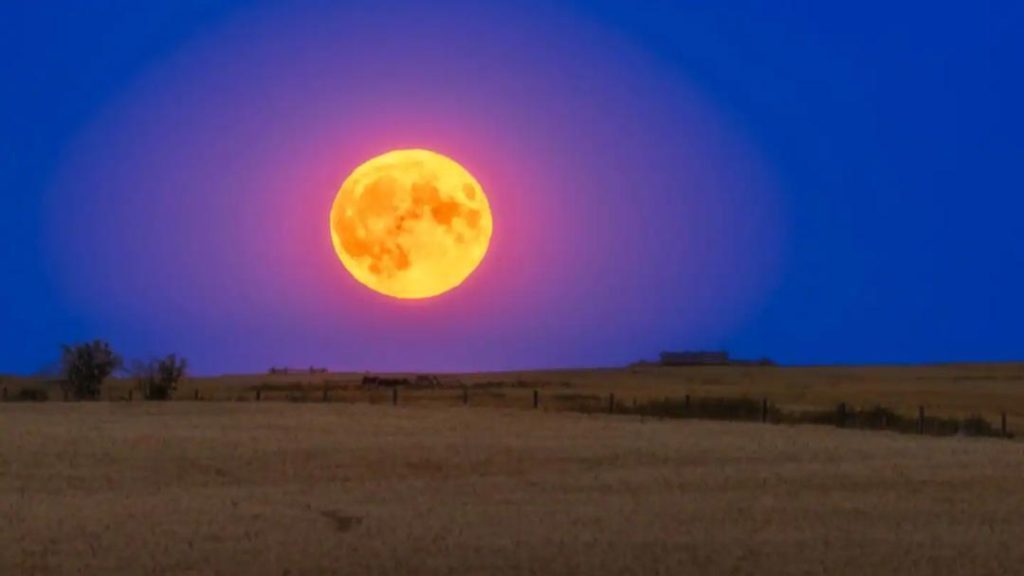
Buck Moon to Light up Skies on July 10 & 11
As the summer season heats up, the night sky is gearing up for a spectacular treat. The Buck Moon, also known as July’s full moon, is set to peak on July 11 at 3:08 am IST in India and on July 10 at 4:38 pm EDT in the United States. This lunar phenomenon has been a significant event in many cultures for centuries, and this year is no exception.
Named by Native American tribes like the Algonquin, the Buck Moon marks the time when male deer, or bucks, begin growing new antlers. This period is crucial for the deer’s reproductive cycle, and the full moon’s illumination provides a unique opportunity for them to roam freely and find mates. The Buck Moon is also a reminder of the changing seasons, as the onset of summer signals the beginning of the deer’s breeding season.
The Buck Moon’s peak timing is unique to each region, depending on the time zone. In India, the moon will be visible in the early hours of July 11, while in the US, it will be visible in the late afternoon of July 10. As the moon reaches its fullest point, it will be an ideal time to observe it, as it will be at its brightest and most prominent in the night sky.
But the Buck Moon’s significance extends beyond its connection to deer antlers. This full moon also marks the beginning of the summer solstice, the longest day of the year. As the moon reaches its peak, it will be accompanied by other celestial bodies, making it an ideal time for stargazing.
Mars, Venus, and Saturn: A Celestial Trio
Before and after the Buck Moon peaks, stargazers will have the opportunity to observe three prominent planets: Mars, Venus, and Saturn. Mars will be visible in the eastern sky around midnight, while Venus will be visible in the western sky around sunset. Saturn, on the other hand, will be visible in the southern sky around 10 pm.
Mars, the red planet, is currently in its opposition phase, which means it is on the opposite side of the Earth from the sun. This alignment provides a unique opportunity to observe Mars, as it is at its brightest and closest to Earth. Venus, often referred to as the “morning star,” will be visible in the western sky as it rises above the horizon. Saturn, the ringed planet, will be visible in the southern sky, its majestic rings a sight to behold.
Tips for Viewing the Buck Moon
To make the most of this celestial event, here are some tips for viewing the Buck Moon:
- Find a dark location: The Buck Moon will be visible from anywhere, but to get the best view, find a location with minimal light pollution. This will allow you to see the moon’s subtle details and the surrounding stars.
- Dress comfortably: The Buck Moon’s peak time is late at night, so dress comfortably and bring a blanket or chair to make your viewing experience more enjoyable.
- Bring binoculars or a telescope: If you have binoculars or a telescope, bring them along to get a closer view of the moon and the surrounding planets.
- Be patient: The Buck Moon’s peak time is short, so be patient and take your time to observe the moon and the surrounding celestial bodies.
- Join a local stargazing event: Many astronomy clubs and local events are organized to observe the Buck Moon. Join one of these events to meet fellow stargazers and learn more about the night sky.
Conclusion
The Buck Moon is a rare and special event that offers a unique opportunity to connect with nature and the night sky. As the moon reaches its peak on July 10 and 11, take a moment to appreciate its beauty and the celestial wonders that surround it. Whether you’re an avid astronomer or just a curious observer, the Buck Moon is an event that will leave you in awe of the universe’s vastness and complexity.
Source:
https://www.newsbytesapp.com/news/science/buck-moon-2025-when-how-to-see-july-s-full-moon/story






